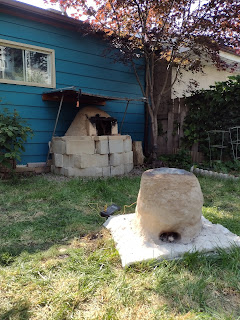Firing the Bronze Clay Furnace
We tried to enter the Bronze Age but can't seem to leave Aluminum!
Last weekend, we fired up the bronze furnace.
We made a hole for the pyrometer about 18 cm from the bottom, brought it out to the backyard, and got a little fire going within it. We lay ceramic fibre down under the furnace too, to further insulate it below (the clay floor is a bit thin).
Then we placed our crucible inside, on a bed of charcoal. It's loaded up with scrap pieces of brass that I had: a door handle, strike plates, some fittings, etc. There was no lid; the charcoal covers it and prevents oxidation.
We added store-bought BBQ charcoal and then more or less sat back and watched it go.
We topped it up a couple of times and sometimes we'd blow some air (lung-powered) into the bottom to get the new charcoal to catch more quickly.
The furnace held up very, very well. A few, thin cracks appeared when we were up quite high in temperature, around 700-800º C.
The highest temperature recorded was 976º C. Being set higher up, the pyrometer gave a reading that was most likely cooler than where the crucible was, completely embedded in coals.
Since we weren't doing any casting, we let the charcoal burn fully and then pulled out the crucible at the end (about 2 hours of firing) to see if the material had melted. It was pretty exciting to see the molten liquid in the crucible! (In the photo, you can see a door strike plate didn't melt.)
I was going to cast it into a muffin tin but ended up spilling it on the grass.
And look, magic! We put in brass and out came... aluminum! 😜
It looks like those door handle pieces were merely brass-coloured! (If you look again at the filled crucible photo above, you'll see the inside of the "brass" is grey, like aluminum.) I wasn't sure it was all brass, but I was pretty sure the ring was. Looks like I was wrong. Or maybe some pieces were brass but most were aluminum? Maybe it was all aluminum? The truth is, we don't know what we melted, because we don't know what we put in. (As computer science teaches us, "Garbage in, garbage out.")
But we learned that the furnace can withstand high heat and functions well without forced air. Can it get high enough to melt brass and bronze? We'll have to wait until next time to be sure.



















So much interesting uncertainty! thank you for documenting andsharing these experiences with us. I am inspired to get back into into the fire craft 🔥
ReplyDeleteIf you get back into it, let us know!
DeleteAnother round about advance! Well advancing back thousands of years but also remarkable verification of the fact that such high temperatures can be reached with the simplest (dare I say primitive) set up. Fantastic. Thanks.
ReplyDeleteThanks for reading and commenting!
DeleteAwesome work, i love this simple yet potent little friend of yours! I wonder if you could go all the way to glass with such "primitive" furnaces/ovens:)) As far as i know some roman furnaces were made of clay and actually used really dry wood for reaching temperatures where glass would melt. Anyway, looking forward for your first *bronze* casting!:)
ReplyDeleteWell, melting glass in such a thing would be amazing! But I must say I'll be sufficiently amazed if we manage to melt brass in it next time. We'll keep you posted!
Delete